Museums and Exhibitions in New York City and Vicinity
| Home | | Museum Guide | | International | | Architecture & Design | | Theater |
GLENN LONEY'S MUSEUM NOTES
CONTENTS, March 16, 2002 You can use your browser's "find" function to skip to articles on any
of these topics instead of scrolling down. In Netscape, drop down the "EDIT"
menu and choose "FIND."
Over 30 mannequins will stand in for Darth Vader, Luke Skywalker,
Yoda, Boba Fett, Han Solo, Princess Leia, & Salacious B. Crumb. Of
course, R2-D2 & C-3PO will also be on hand.
The current show has been touring for some time, but I saw the initial version
of it seasons ago in San Francisco at the Yerba Buena Center. This debut showing
was a gift of Lucasfilm's Industrial Light & Magic™, a Marin
County neighbor.
To avert critical objections that a serious art & research museum has no
business giving precious space to what might be regarded as a crass promotion
of Hollywood Products, the Brooklyn Museum is enhancing the Star Wars™
artifacts with treasures from its own holdings.
After all, the Guggenheim has shown some smashing Motorcycles. And the American
Museum of Natural History is currently featuring Baseball! So why not some
popular movie-props?
The BMA has had enough trouble already with controversial exhibitions of
artworks which outraged the former Mayor, Rudolph Giuliani. Surely this is
a show that Mayor Michael Bloomberg will love?
Searching for an academic 'hook" for the new show, the Brooklyn Museum ingenuously
has fallen back on mythology.
Emphasizing the inspirational debts of Star Wars™ to the essays of
the late Myth-Expert, Joseph Campbell, BMA's scholarly gloss is titled: The
Myth of the Hero and Heroine.
Museum artifacts will include a Yoruba mask, a Polynesian club, and a head
ofQueen Cleopatra VII—the fabled lover of both Julius Caesar
and Marc Antony!
This is certain to be a Blockbuster! And be sure to visit the Brooklyn Botanical
Garden right next door! In April, it will be in full bloom. Waiting for Bloomberg…
[01] STAR WARS™ Coming to BMA
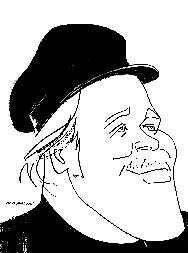
Caricature of Glenn Loney
by Sam Norkin.
[02] ARTEMISIA & ORAZIO at the Met
[03] Met Shows SURREALISM: Desire Unbound
[04] Ancient Chinese Art from Sechuan
[05] At the Met: EASTER ISLAND Head & Artifacts
[06] Benjamin Brecknell Turner: Early Victorian Rural Photography
[07] Met Exposes IRVING PENN'S NUDES
[08] WHITNEY BIENNIAL on Madison & in Central Park
[09] 40 Years of GERHARD RICHTER at MoMA
[10] Morgan Evokes PIERRE MATISSE GALLERY
[11] NEW WAY OF TEA at Japan & Asia Societies
[12] St. David's Renaissance Stained-Glass Panels Saved
[13] GRANDMA MOSES Reflects Ameria at St. Etienne
[14] Bard Explores UTOPIA & REALITY in Modern Sweden
[15] MIRRORING EVIL; Nazi Images at Jewish Museum
[16] Echoes of Death in Dachau
[17] OSKAR KOKOSCHKA's Early Portraits at Neue Galerie
[18] FORGOTTEN NABI: Charles Lacoste
[19] Miniature Shoes at Hermès
[20] Butkin's FRENCH MASTER-DRAWINGS at Dahesh
[21] NANCY GRAVES at CUNY & Knoedler
[22] STEINBECK CENTENARY PHOTOS
[23] ARE WE ALONE? at the Hayden Planetarium
[24] BASEBALL AS AMERICA at Natural History Museum
[25] Rachel Whiteread's Big White Plaster Casts at Guggenheim
[26] Art & Antique Shows Return to Armory
ALERT! ALERT! ALERT! ALERT! ALERT! ALERT!
Coming to the Brooklyn Museum of Art—
STAR WARS: The Magic of Myth
[Opening April 4—Closing July 7, 2002] Marvelous miniature
models and outrageously original costume-concepts from the Star Wars
Trilogy™ will be on view at the Brooklyn Museum of Art, So large
is this traveling exhibition—and even larger in Brooklyn than anywhere else—that
it requires two entire floors to display its wonders.
ARTS PANORAMA AT MET MUSEUM—
ORAZIO & ARTEMISIA GENTILESCHI:
Father & Daughter Painters in Baroque Italy
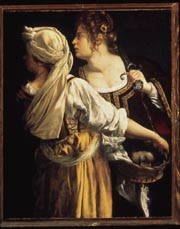
|
|
| JUDITH AND HER MAIDSERVANT--An Artemisia Gentileschi Masterpiece at the Met Museum.. | |
And her brutal rape at the hands of one of her painter-father's colleagues—already the lurid centerpiece of a major movie about her—would almost qualify her as a virginal victim, a Martyr for Art?
Viewing Artemisia Gentileschi's gory, almost clinical, visions of Judith Slaying Holofernes suggests something of a Revenge Fantasy, playing itself out large in an ostensibly Religious Canvas.
In 17th century Rome, aspiring women painters were not warmly welcomed to the Academy. Artemisia was fortunate in having an extremely talented painter-father, from whom she could learn both art and craft.
The Metropolitan's big new show offers 50 works of father Orazio, who approached greatness when he came under the influence of Carravaggio's technique of light and shadow.
In his time, Orazio's fame far overshadowed that of his daughter, who nonetheless executed major commissions and created some extremely powerful paintings of traditional biblical subjects. Both had distinguished and intriguing careers.
There are 32 of Artemisia's impressive portraits and thematic paintings on display at the Met, on loan from major museums and private collectors.
Because a number of the great framed canvases were created as large altar-pieces, they tend to be overwhelming. Given the religious subjects, some are even oppressive or obsessive, despite their great technical mastery.
This is a large-scale, handsomely-designed exhibition which should appeal to a wide range of art-lovers and museum-goers. But it should have special appeal to ardent Feminists and disciples of Women's Studies.
SURREALISM: Desire Unbound

|
|
|
SALVADOR DALI'S LOBSTER TELEPHONE--SURREALISM Sex-Object at the Met. |
|
And some of those: with very good reason, for they are not very good works, either as imaginative expressions, inventive creations, or even technical achievements.
But those qualities were obviously of little concern to the curators of this show from the Tate Modern in London.
This is in no way intended as a Survey of Surrealism—which may be what some viewers will be expecting to witness at the Met.
The sub-title says it all: Desire Unbound. The focus is somewhat diffusely narrowed to sexual fantasies, images, symbols, and obsessions of major and minor Surrealists.
A number of the canvases, collages, constructions, and illustrations are colorful, surprising—even today, amusing, darkly mysterious, and often intriguing. Others seem to have been included only because they are sex-referential.
Although it's unclear how Salvador Dali's black telephone—with a red-lobster for the hand-set—relates to sex…
Peter Plagens, in Newsweek, offers this suggestion: "Phone sex, anyone?" He also provides some titillating sexual backgrounds for some of the artists in the show.
There are more than 300 Surrealist sex-art-objects on display, although there were even more at the New Tate.
Major critics have made the show's thematic obsession very clear in their reviews. And their editors—or headline writers—have made the point even sharper:
"Surrealistic Pillow Talk" [Mark Stevens/New York Magazine]
"The Surrealists' Sexy Side" [Peter Plagens/Newsweek]
"Sexual Fantasies of Surrealists" [Hilton Kramer/Observer]
Kramer's review is sub-titled: A Misshapen Behemoth of Putrid Fantasies.
For Kramer, this show is yet another example of the recent and ominous official trend—at the New Tate Modern, MoMA, and the Centre Pompidou, among other modern museums—to organize exhibitions around themes or topics. Rather than offer artistic chronologies or comparisons of aesthetic and technical excellences.
Kramer comments: "Most of the art, however, is pretty bad." Even the included works by Salvador Dali and Max Ernst—despite their aesthetic credentials—are, says Kramer, "likely to leave you cold, if not indeed shuddering."
Given the almost universally interesting topic of sex, this is a show you may well want to check out for yourself. Putrid or not…
Treasures from a Lost Civilization:
ANCIENT CHINESE ART
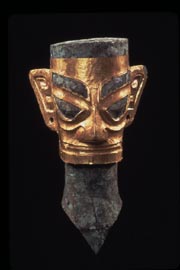
|
|
| GOD IN A GOLDEN
MASK?--Met Shows Ancient Chinese Art & Cult Object. |
|
Previously, this southwestern area was thought to have been a primitive backwater until modern times. Indeed, before these sensational archeological finds, the nearby city of Chengdu was most famous for its Pandas. And Sechuan [US spelling] Cuisine, of course…
These amazing bronzes, ceramics, carved stone and jade, and gold jewelry go back in time as far as the 13th century BC, extending to the third century AD. The elegance and stylized sophistication of the gilded bronze masks and figures is amazing for such an early date.
Not only do the helmets, weapons, armors, and carved or incised reliefs reveal much about the World of Men in these ages lost in the mists of history. But small objects, utensils, decorative details, and carvings also show elements of daily-life, rituals, nd festivals.
The ornate ritual burials were not intended as Time Capsules for our age, but they have certainly proved to be just that.
If you merely love beautiful objects—and admire magnificent craftsmanship—you
do not have to be an archeologist or a museum-curator to find this wonderful
loan exhibition from China fascinating.
Organized by the Seattle Museum of Art—in collaboration with Sichuan—the
show includes some 128 remarkable artworks. For those who love horses, there
are several notable equine images.
SPLENDID ISOLATION:
Art of Easter Island

|
|
|
BIRDMAN OF EASTER ISLAND--At the Met Along With Giant God-Head. |
|
The great mysterious standing stone heads have become a symbol worldwide for Easter Island. Though not many tourists have made the trip to this isolated Pacific island.
At the Met, only the head of one of these immense stone images—or moai—is on view, on loan from the Smithsonian. It certainly suggests the majesty which a row of such figures can evoke.
The rest of the exhibition deals with interesting smaller objects relating to daily-life and religious rituals. Among these are the birdman figures of Makemake, the most potent island god.
The German Expressionist, Max Ernst, was inspired by these figures and their rituals.
The great inscrutable stone faces atop their tall rock shafts were carved of volcanic rock and moved great distances to be installed at temples along the coastline.
Representing honored ancestors, they were set up facing inward to protect the islanders. White coral eyes were placed in their stony sockets to awaken the ancient spirits during rituals.
The island takes its name from its Easter Sunday 1722 discovery by a Dutch explorer. Nearly 150 years later, the islanders were converted to Christianity. After which they unfortunately destroyed most of their pagan ritual records, written in rongorongo, a kind of hieroglyphic language.
A few surviving tablets are on view now at the Met. But no one knows how to read them…
Benjamin Brecknell Turner:
Rural England Through a Victorian Lens

|
|
|
A TREE GROWS IN LONDON--Benjamin Brecknell Turner's Vintage Victorian
Photo of The Crystal Palace. |
|
That anyone with money enough to afford one of those cumbersome early cameras, leisure enough to wander around the countryside looking for likely images, and patience enough to wait for the various subjects—ancient trees, contented cows, ruined abbeys, or smoking cottage-chimneys—to be properly exposed, would today be hailed as one of Photography's Early Masters.
Similarly, such a camera-owner—if he could get his relatives to sit still, frozen in place, long enough to expose his photographic-plates—would now be recognized as a Master Portraitist. Of course, even in his own time, David Octavius Hill was admired as a photographer of what today look like very quaint old Scotsmen and women.
Benjamin Brecknell Turner seems to have been just such a dedicated gentleman-amateur, who had the good sense not to concentrate on family-portraits.
His large-format photographs of scenes of the English countryside, villages, ruined churches & castles, and even a rural windmill now provide a handsome and valuable record of a bygone age.
But at the time, he made only a few copies of each image. The current show of 40 Turner photos is drawn from the handsomely-bound family photo-album he made of his prints: Photographic Views From Nature.
Because there were so few men—and even fewer women—who had the money, time, photographic-equipment, and experience to rove about London and farther afield in England recording images of things which had been standing or growing in the landscape for years, Turner's photographs today do provide a valuable record. And his images of such structures as the famed Crystal Palace—now vanished except for a few fragments of sculpture—provide important documentation.
His suite of photos of Whitby Abbey, in Yorkshire, show it much as it looks today—still an ancient ruin. But it was here—at the great Synod of Whitby—that the date of Easter was set in the Christian calendar!
"Set" may not be the right word, as the date of Easter keeps shifting from March to April and back again. Turner's camera tripod was more firmly in place than Easter now is…
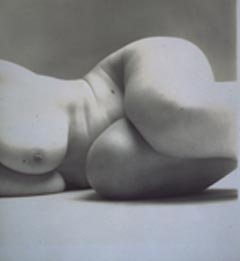
|
|
| AN IRVING PENN NUDE--But Topless at the Met! | |
EARTHLY BODIES:
Irving Penn's Nudes/1949-50
[Closing April 21, 2002] The Met's semi-chaste display of
Irving Penn's fleshy headless women offers 60 black & white photos he made of
several Rubens-esque artists' models in bare studio-sessions over half-a-century
ago.
This is the first major museum exhibition of the nudes. No one would have dared to show this suite of chubby, flabby ladies way back in 1949.
Minus their heads, these torsos become odd objects of ambiguous, even abstract, sculpture. They are certainly not pornographic. Anything but. Unless you have the libido of an Old Dutch Master, you won't become aroused while touring this show.
The Met's press-release is fairly on-target: "…their fleshy torsos are folded, twisted, and stretched, with extra belly, mounded hips, and puddled breasts. Sisters of Titian's and Rubens' Venus, they are charged with powerful physical and sexual energy, yet remain somehow chaste."
These you need to see for yourself. Don't take either my or the Met's word for it.
In these perilous times—when half the population is obese, and the other half anorexic—it's unfortunate that Penn's lenses are not interpreting this dire dietary phenomenon. Fergie & Monica would have been interesting subjects for Penn, had they been around circa 1949!
Penn Also at the Whitney—
Dancer: 1999 Nudes by Irving Penn
[Closing May 12, 2002] More Penn nudes. Less flab. But still no Fergie & Monica…At the Whitney & Central Park—
THE WHITNEY BIENNIAL 2002
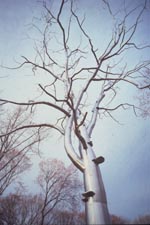
|
|
|
MAYOR BLOOMBERG STOOD HERE--Roxy Paine's Whitney Biennial BLUFF Tree in
Central Park. |
|
Thus, the most innovative element in the new cutting-edge exhibition is exposing artworks in Central Park, as well as on Madison Avenue, in the Whitney's Marcel Breuer space-sculpture.
Unveiling the current Biennial for the press, Anderson even had to stage two previews in sequence. The first, in Central Park—between the Mall and the Sheep Meadow—featured New York's new Mayor, the Honorable Michael Bloomberg.
His Honor was only slightly upstaged—or up-parked—by a large leafless multi-branched silvery metal tree. This arboreal wonder is the work of Roxy Paine. It is called Bluff, but it wouldn't fool a bird. The Mayor took questions from the press about city matters.
Four other Biennial artists are now on view in Central Park as well. Kiki Smith's birds with human heads—Sirens and Harpies—are at Central Park Zoo. Kim Sooja's Korean bed-covers, in a range of pastel colors, now serve as table-cloths in the Zoo's Leaping Frog Cafe. They are collectively titled: Deductive Object. So, don't spill the catsup!
Fronting the Grand Army Plaza—and its adjacent Grand Hotel—are Keith Edmier's two commemorative military memorials. They are 3/4 life-size, rather less grand than other sculptures in Central Park.
These two World War II soldiers are Edmier's two grandfathers. So that the public may appreciate the artistic power of these totally conventional statues—and the other park-sited artworks—the Whitney has provided a Central Park route-map brochure, spotting the pieces. And explaining their cultural, social, and aesthetic significance.
It has this to say about the Two Old Soldiers: "…Edmier uses personal narrative to complicate the notion of public statuary, even as he creates a tender tribute perhaps more immediately accessible than the larger-than-life memorials nearby. Edmier's elegiac sculptural works…often skirt the distance between private experience and collective cultural memory."
Then again, they could also be seen as smaller-than-life conventional renderings of men in uniform…
In the Main Tent at the Whitney—
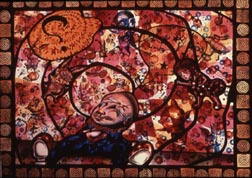
|
|
|
STAINED-GLASS RUN RIOT--Judith Schaechter's Bigtop Flophouse Bedspins
at the Whitney Biennial. |
|
Various Video Conceptions are on display, as electronic media invade the ether once sacred to painting and sculpture. And there are both powerful photo-images and deliberately blurred ones as well.
Chris Ware's retro Art Deco-style cartoon images for Jimmy Corrigan, the Smartest Kid on Earth are a delight. As are his cut-out cardboard objects for the ACME Novelty Library. They recall similar Depression Era cut-outs—with which you could Make Your Own Movie-Projector, among other wonders.
Anne Wilson's Topologies is truly wonderful. On a long dead-white rectangular surface, Wilson has artfully arranged hundreds of fragments of black-lace.
Seen first from a distance, this looks like a miniature-railroad display. Viewed closer, the tiny black bits and pieces look like dried—and possible dangerous—insects. From any angle—as the arrangements and the intricacy of the lace fragments invite close study—this work has an almost hypnotic fascination.
At first glance—when I was still thinking miniature model-railroads—it reminded me of a similar dead-white rectangle with white trains, white tracks, and tiny white buildings.
This sculptural work is in the British War Museum in London, and it grimly recalls the arrival of new victims for the gas-chambers of Auschwitz.
This Biennial doesn't seem to have any Major Outrages, unlike recent shows. Some titles are more provocative than the actual artworks. How about Yun Fei-Ji's A Monk's Meditation on a Woman's Vagina Being Interrupted?
But—if I had any surviving open wall-space—the only works on view I'd really like to own and study often are the wonderfully inventive and intricate stained-glass light-boxes of Judith Schaechter. Her Speech Balloon is my favorite, but Pale Oval and Bigtop Flophouse Bedspins are also compelling.
At the Museum of Modern Art—
Gerhard Richter: Forty Years of Painting

|
|
|
LOOK AWAY, BETTY!--Gerhard Richter's Portrait at MoMA Retrospective. |
|
Born in Dresden in 1932, Gerhard Richter was a child under Nazism. Hitler came to power in 1933. Richter's early experiences of the arts as a schoolchild were thus purged of all contact with Degenerate Art.
With the defeat of Germany in 1945, Richter and all of what became East Germany made the transition to a new form of authoritarian regimentation, the Communism of the DDR. The artistic standard—Socialist Realism—was little different from the Nazi Ideal, though it now substituted Soviet Soldiers for Aryan Helden.
Fortunately, Richter was able to move to West Germany before the Berlin Wall was constructed in 1961. At last he was able to explore modern influences from across the Atlantic, as well as among young German artists of his own inclinations.
While there are examples of varying stylistic effects, many of the major canvases in this show of 188 Richter works evoke the quality of blurred photographs. Which is indeed the painterly equivalent of such an effect.
It can be haunting—as of a person, object, or landscape seen dimly through a mist or spattered glass. Or it can be frustratingly out-of-focus, deliberately imprecise, anonymous, ambiguous.
Richter's monochromatic series dealing with the deaths of the Baader-Meinhof "Gang" of 1970s anarchist/terrorists is especially arresting. Especially in these times of Orchestrated Terrorist Hysteria…
As MoMA's press-release phrases it: "Richter has challenged painting to meet
the demands posed by new forms of conceptual art."
At the Morgan Library—
Pierre Matisse and His Artists
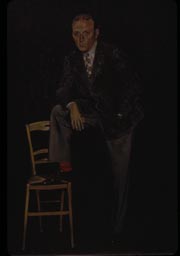
|
|
|
LOOK THIS WAY, PIERRE!--Portrait of Manhattan Gallery Guru Pierre Matisse
at Morgan Library. |
|
But Pierre Matisse conducted his influential career at a safe distance from his father and the City of Light. His important gallery was in the Art Deco Fuller Building on East 57th and Madison Avenue. Today, the Fuller is still home to a number of major art-dealers.
Of course the son represented his far more famous father. But Pierre Matisse was much more important in the development of the careers of major modern artists by introducing them to major American collectors in Manhattan and across America in the decade before World War II.
This remarkable exhibition is the first show of 20th century painting and sculpture at the Morgan. It features notable drawings, paintings, and sculptures by artists Matisse championed. And the inspiration for the show is the gift to the Morgan Library of the Matisse Gallery Archives.
Thus, important documents and personal letters—including an angry missive from Sandy Calder—relating to Matisse's shows, sales, and relations with his artists are also on display.
Among the major works now at the Morgan are icons of the achievements of Calder, Chagall, Tanguy, Miró, Balthus, Giacometti, Matta, Dubuffet, Derain, Lam, MacIver, and Rouault.
Although Morgan has long presented exhibitions of its rare books, illustrated manuscripts, ancient seals, and priceless drawings, engravings, and prints, it has seldom included major sculptures in shows. The Matisse Connection, however, made this almost obligatory.
But this may be a Harbinger of Change at the Morgan. Plans have been approved to reconform the two major components of the Morgan Library, now facing East 36th Street. Proposals include the Morgan Mansion and the glass atrium, creating an impressive new Madison Avenue entrance, greatly expanded exhibition space, and additional sub-level storage, conservation, and office-space.
Unfortunately—as with the ongoing construction of the new MoMA on West 53rd Street—the forecast is for a closure of the Morgan Library to the public until 2005.
MoMA is completing a Queens alternative exhibition-space in the old Swingline Stapler factory. Morgan alternatives have not been announced.
At the Japan Society Gallery
& the Asia Society & Museum—
THE NEW WAY OF TEA
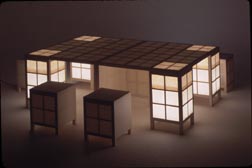
|
|
|
THE NEW WAY OF TEA--New "Tea-Space" at Japan Society Show. |
|
And the crowds of arts journalists and critics who turned out at both the Japan Society and the Asia Society were so large that participation in a demonstration of the traditional Tea Ceremony was out of the question.
But then this new show is not so much about tradition as it is about the changes in preparing and enjoying a cup of Japanese tea, thanks to the growth of international interest in such distinctively Japanese rituals and customs.
So, both on Madison Avenue and opposite the United Nations, Japan and Asia are currently showing handsome new objects for preparing and serving tea. As well as some very unusual models of new tea-houses for the New Way of Tea.
Some of these must be Modernist models, for they seem much too small for even diminutive Japanese ladies to crawl into.
They are all Minimalist in design and furnishing, as befits Japanese interior
decoration, which has been Minimalist, in effect, for centuries.
One of these tea-venues, forged out of unforgiving metals, looks more like
a detention cage than a place of pleasure and contemplation.
Most interesting of the tea-locales is Choan, or
Long Abode, a long narrow room with two long parallel benches and a tea-preparation
table at their head.
Most beautiful, and most evocative of traditional Japanese bamboo and rice-paper
shoji screens is the glowing "Between" tea-space,
designed by Masayuki Kurokawa. The translucent tabletop rests on four corner
squares, illuminated from inside.
They are part of a priceless cycle of windows, based on the story of St.
Mary Magdalene, as told in The Golden Legend. [Her
tomb is somewhere in the south of France, in fact!]
WR "Citizen" Hearst acquired them—along with literally tons of antiquities
and rarities from all over Europe and the Americas—only to put them in storage
in New York.
To raise money when his newspapers were losing ground, he had an auction
of many rare items—including Benjamin Franklin's spectacles—which was featured
in LIFE magazine: LIFE GOES TO AN AUCTION.
When things got really bad—and the fabulous Hearst Castle at San Simeon
seemed ready to go on the block—his actress-mistress Marion Davies even sold
her jewels to help him! Now that's Love with a Capital L. His wife, Millicent,
who refused him a divorce, was not so charitable.
Although two stained-glass panes of the Magdalene Cycle were sold at Gimbels
in 1941—present location unknown—the surviving ensemble was given to St. David's
in 1958 by the Hearst Family. Two young Hearsts were enrolled at that time.
Unfortunately, time and harmful restorations had damaged the glass-elements
and the leadings. Soot and grime had also obscured their beauty.
In 2001, a remarkable restoration of the windows began in Brooklyn at the
Stained-Glass Conservation Studio of the St. Ann Center for Restoration and
the Arts. This work—and a new training program at the Brooklyn High School
of the Arts—is supported by the World Monuments Fund.
The Fund is currently showing the restored windows, with accompanying photos
and texts about them and the actual restorations. The Fund is on the 9th floor
at 95 Madison Avenue. Phone: 646-424-9594.
The Fund is active worldwide in the preservation of important monuments,
buildings, decorative arts, and similar treasures of history, architecture,
and design.
In fact, I've just returned from the great temple-complex of Angkor Wat
in Cambodia, where the World Monument Fund is busily restoring a ruined temple!
Effectively "discovered" and introduced to New York art-collectors as Grandma
Moses, she enjoyed a tremendous vogue in the l940s. Especially during the
War Years, homespun views of American Life were reassuring.
Grandma Moses was no Norman Rockwell. She had no training, no Cute Ideas,
and no real agenda. She did develop a technique, however. As she told a documentary-film-maker,
she painted "from the top down," beginning with the sky.
Otto Kallir, founder of the Galerie St. Etienne—which still has Grandma
Moses artworks and crocheting for sale—did not actually discover her. That
credit belongs to Louis Caldor who first recognized the very special quality
of her Naive American Art in Upstate New York. But it was Kallir who made
her famous—and collectable.
To mount its current Grandma Moses exhibition, the gallery was able to draw
on paintings in a number of private collections. As well as on its own holdings.
For those born long after the Grandma Moses Vogue, the almost child-like
quality of her scenes of rural and village New England life may be baffling.
People actually paid Big Money for these apparently amateurish images? With
people totally out of scale with their surroundings?
Well, the 1940s was/were Another Age Altogether. You had to have been there…
But Grandma Moses can still cast a spell. And her use of finely ground glass-glitter
to make the snowy trees sparkle recalls Victorian Greeting Cards!
But long before Danish modern furniture—or the Second World War—Swedish
Modern Design was making its mark in Europe and the New World.
The current exhibit at Bard—organized by Stockholm's Moderna
Museet—documents the origins and development of Swedish Modern
from the beginning of the 20th century.
Architecture, artworks, decoration & ornament, and utilitarian objects—all
notable for their often stark Modernism—are included. As the town-house galleries
of the Bard Center are intimate, photos and texts do much to flesh out the
design-narrative.
A painting by the obsessive, tormented Swedish playwright, August Strindberg,
will be on view! As will designs by the famed Erik Gunnar Asplund.
But this show is much more than a Scandinavian Saga of Design. It relates
the developments in the arts, in architecture, furniture, ceramics, fabrics,
and glassware to social, political, and cultural changes in the North European
democratic monarchy—long dominated by Socialist Agendas.
Stockholm is much older than Singapore, but it is something like that distant
Asian city in its mixture of old and new, of Modernism and Tradition. And
also in its social concern for all levels of society, in housing, education,
and Quality of Life. And its cleanliness, though they do not have to cane
Swedes to keep the streets clean…
Such things are not only the result of Social Planning, but also of artistic
vision in architecture and design.
Mid-March, the ways in which Swedish Modernism developed—shaped by and shaping
Swedes and Sweden—will be explored at Scandinavia House in a day-long seminar.
Titled DESIGNING IDENTITY: Swedish Modernism, its
lectures and discussions are sure to be published.
Nonetheless, there was an evident fascination with the sinister bearing
and the uniforms of Hitler's Supermen. As well as with the elaborate torchlight/searchlight
Nuremberg Nazi Party Rallies, stage-managed by Hitler's favorite architect,
Dr. Albert Speer.
In the half-century after the defeat of the Nazis—if not entirely of their
ideologies—Hollywood has continued its strange, almost perverted, romance
with the image of Nazis in Uniform and forests of swirling Swastika Banners
on tall poles.
During World War II, Charlie Chaplin mocked the symbols of Nazism in The
Great Dictator. As did Walt Disney, in Donald Duck
in Nutziland.
Subsequent films, however, have seldom been mocking or parodic.
In recent years, however, a generation of artists who could not have had
any actual wartime experience of the Nazis and their horrendous doctrines
and acts has grown up. Their "take" on Nazi imagery—relating it to contemporary
Consumer Culture—has offended many who survived the Nazis.
But it has amused others, born long after 1945. But, to some observers,
it has seemed to make pointed social and cultural comments as well.
Because the comprehensive catalogue for this new exhibit at the Jewish Museum
was available well in advance of the show, angry controversy has been brewing.
Some critics are outraged that such an exhibition would be mounted anywhere—but
especially not at the Jewish Museum.
Obviously, with its past record of outstanding exhibitions examining & celebrating
Jewish Traditions, Beliefs, Culture, Art, Life, and Suffering—as well as its
impressive permanent core-exhibition, The Jewish Journey—the
Jewish Museum has no intention of gratuitously offending anyone. Except possibly
surviving Nazis and new Neo-Nazis…
The over-arching purpose of this disturbing show is to provoke thought and
active discussion about what the Nazi images have come to Be or Signify in
contemporary society. To that end, there will be extensive forums and educational
programs to confront or appreciate the actual exhibition and the submerged
agendas with which it is concerned.
Among the artists whose works are on view: Roee Rosen, Alan Schechner, Piotr
Uklanski, Boaz Arad, Mat Collishaw, Tom Sachs, Mischa Kuball, and Christine
Borland.
Not to be missed!
His evident objective is to emphasize the impotence of "NEVER AGAIN," in
the face of centuries-old and unreasoning racial, ethnic, tribal hatreds.
In the context of recent events, not only in the Balkans—but also in Asia
and the Middle East—Music's prophecy that those who died so horribly in Dachau
were hardly the last will haunt the future as well.
At the World Monuments Fund—
Masterworks in Stained Glass:
[Closing May 15, 2002] Unless you are one of the Young Private
School Elite on the Upper East Side—or a Tuition-Paying Parent—you probably
have never seen the William Randolph Hearst French Renaissance stained-glass
windows his family donated to St. David's School.
W. R. Hearst/St. David's Renaissance WindowsAt Galerie St. Etienne—
GRANDMA MOSES: Reflections of America
[Closing March 16, 2002] On West 57th Street, Anna Mary Robertson
Moses lives again!
At the Bard Graduate Center—
Utopia & Reality in Modern Sweden: 1900-1960
[Closing June 16, 2002] In the wake of World War II, Danish
Teak was Very Big. Although American talents such as Russel Wright and Charles
and Ray Eames were putting their very special stamp on Modern Design, the arts
& crafts of Scandinavia also exerted a great appeal.
At the Jewish Museum—
MIRRORING EVIL: Nazi Imagery/Recent Art
[Closing June 30, 2002] Even before the Second World War,
Hollywood film-makers showed a curious fascination with German Militarism and
Prussian Authoritarian Traditions. World War II transmuted this into anti-Nazi
propaganda films.
An Artist's Response To Evil:
[Closing June 30, 2002] Also at the Jewish Museum, this series
of watercolors and acrylic paintings by Music recalls dead Nazi victims he sketched
when he was a prisoner in Dachau Concentration Camp. The powerful, haunting
images were made from 1970 to 1987, from his KZ drawings.
"We Are Not the Last" By Zoran MusicAt the Neue Galerie—
Oskar Kokoschka:
Early Portraits from Vienna & Berlin/1090-1914

|
|
|
NEUE GALERIE & AUSTRIAN ART--Joseph Hoffmann's 1904 <i>Jugendstil</i>
Brooch. |
|
This amazing woman was also muse to Zemlinsky and Gropius. If you want to see a vision of the young Alma, OK's portrait of her is now on view at the Neue Galerie. And Tom Lehrer has written a very amusing song about her mysterious charms over some of the 20th century's greatest artists, musicians, authors, and architects. Whatever "IT" was, Alma had it.
The new show in the Galerie's elegant Fifth Avenue Palast brings 30 of Kokoschka's early oil portraits together. Painted between 1909 and 1914 in Vienna and Berlin, these signature images include Peter Altenberg and Kokoschka's mentor, the tendentious Viennese Modernist architect Adolf Loos.
There's also OK's own idea of himself: Self-Portrait as Knight Errant.
Also on view are Kokoschka sketches of notable sitters, as well as designs made for the Wiener Werkstätte. These include striking posters, post-cards, and fans in the immensely popular Jugendstil/Art Nouveau mode.
Below, in the second-floor gallery, important works of Austrian art & design from the inaugural exhibition remain on display. On the ground-floor is the admirable Café Sabarski, which recreates not only the character & ambiance of a Vienna Coffee-House, but also offers Konditorei confections par excellence.
At the Wildenstein—
Charles Lacoste: A Forgotten Nabi
[Closed mid-March] In Paris, they didn't call it Jugendstil—the New Youth Style—but Art Nouveau. But some of the paintings of Charles Lacoste on view at the Wildenstein would not have been out of place in Vienna among collectors of the creations of the Wiener Werkstätte.Lacoste's 1895 Ville, femme au parapluie would in fact have made a handsome Wiener Werkstätte poster or post-card! His charming oil of Men Reading On a Bench has the same spare simplicity.
The visually simplifying influence for this Nabi stylist came not from Vienna, however, but from the stylized restraint of Japanese painting and decoration. This was a major influence in the late 19th century on the Continent, also affecting American and British painters.
Although Lacoste may today be almost forgotten, the 40 oil-paintings too briefly at the Wildenstein suggest it is time for much wider exposure of his work. His circle included the Nabis Félix Vallatton and Édouard Vuillard, as well as writers such as Andre Gide.
At Maison Hermès—
SHOE SIDESHOW: Question of Size
A rather different exhibit of French art & style is Question of Size, recently at the 691 Madison Avenue flagship of La Maison Hermès. Designed by M/M of Paris, this was a fantasy about Hermès shoes!The show has now moved on but will surely be seen elsewhere in boutiques specializing in Hermès' luxury merchandise. It can travel with ease as it consists of a rack of miniature Hermès shoes & boots, tightly packed into a large leather Hermès zipper-bag!
Even minus this unusual collection of footwear—which was on display in the fourth-floor atrium-rotunda—Hermès is well worth a visit. The store is awash in Hermès' fantastic trademark scarves and other handsomely embellished fashion accessories. There are even boots & saddles, as well as silver, dinner-settings, and you-name-it. With prices to match the elegance of the artifacts…
You can identify the store from the name Hermès alone. But you can also espy it from afar thanks to the flag-flaunting Revolutionary Rider on Horseback atop the roof. The Paris Hermès HQ—in the rue du Faubourg Saint-Honoré—also features this fearless Napoleonic horseman on its roof.
As with many of the handsome flagship showcase stores which line Madison Avenue from the upper 50's through the mid-80's, there are often more handsome and handsomely-dressed sales-personnel on hand than there are customers.
Nota Bene: Stanford University's famed socio-economist Thorstein Veblen may have got it right about Conspicuous Consumption—in his Theory of the Leisure Class.
But, at the moment in Manhattan, this class of consumers is being much less conspicuous.
Perhaps these potential purchasers are secluded at home, counting their ill-gotten gains from dumping their Enron stock before that Energy Giant's titanic collapse?
After such a financial debacle, perhaps the President ought to rethink his idea of encouraging Seniors to squander their Social Security benefits in Stock Market Speculation?
Or will he bless this initiative by establishing Faith-Based Mutual Funds? One might just earn enough to buy a Hermès scarf!
At the Dahesh Museum—
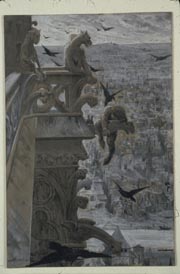
|
|
|
HANG ON, QUASIMODO!--Nôtre Dame & Gargoyles at the Dahesh. |
|
Muriel Butkin's French Master Drawings
[Closing May 18, 2002] For those who flee—in incomprehension—from Post-Modernist, Minimalist, and Conceptualist art-exhibitions, the Dahesh Museum always provides a small-scale safe-haven. It is devoted to Academic Art, which was anchored in tradition, training, technique, and artistic talent.Although often romantically or fantastically inflected, its images of Man, History, Religion, and Nature were nonetheless based on recognizable realities.
The Rise of Modernism—and the ardent rejection of all kinds of Authority, including that of Academies of Arts—soon discredited such artworks. And often consigned them to museum storage-vaults.
At the intimate Fifth Avenue Dahesh Museum, however, they once more make their claims for attention and admiration. Often, virtually forgotten masterworks will be on display, after years of neglect.
The current show is an excellent selection from the collection of Cleveland's Muriel Butkin. She has not only had the money, but also the eye to assemble an admirable range of 18th & 19th century French drawings. The collection has been shown at the Cleveland Museum of Art—to which it is promised.
The Manhattan Dahesh show is the only other venue for these handsome works.
Among them are such arresting images as Luc-Olivier Merson's gargoyles—with
Quasimodo clinging to one of them—in Nôtre-Dame de Paris.
Among the Famous Names of academic artists on view are Rosa Bonheur, with
Return from the Horse Fair; François Boucher, Male Academy with
Wings; Hubert Robert, Palace with an Arched Bridge; and Jacques-Louis
David, with his study of the Sabine statue in the Villa Medici.
Using images and elements from both the distant and recent past in these
late Graves constructs, the adventurous artist managed to evoke ghosts of
ritual and romance in virtually futuristic collages of materials.
In some pieces, Graves runs riot with iridescent colors more often found
on Carnival Midways. But here they bring life and joy to otherwise mute metal.
Her materials include cast & fabricated aluminum, glass, and polyester resin.
And color, lots of color!
The head of the Venus de Milo and Michelangelo's Creation of Adam
are ingeniously co-opted.. Some elements—especially artifacts from Ancient
Egypt—are recycled in various ways in different works.
The handsome Nancy Graves brochure is well worth keeping on file. Not only
for the color reproductions, but also for Curator Diane Kelder's appraisal
of the works.
Ms. Kelder also created a valuable booklet for the previous gallery show,
Esther Boise Van Deman: An Archeologist's Eye. This
was a selection of evocative black & white photographs of Rome's ruined, crumbling
antiquities.
These images were on loan from the American Academy in Rome. They were made
early in the 20th century when Van Deman began her lifelong researches in
Rome—among the ruins and the often disastrous incursions of the modern world.
Works of the late Nancy Graves are also currently on view at Knoedler &
Company, closing April 27. This show is AVES: Forms in Flight.
Her images of frigate birds and flamingos are memorable. And quite a contrast
to her CUNY show!
What the new CUNY Art Gallery lacks in expanse of space, it makes up in
quality and selectivity, thanks to the resourcefulness of the Grad Center's
Ray Ring. His impressive title is Director of Building Design and Exhibitions.
Personal Disclosure: Over 15 years ago—maybe even 20—Ray
Ring proposed to present your reporter at the CUNY Graduate Center, then on
42nd Street, as a "New York State Artist."
This was flattering—and not a little unsettling—as I was a Professor of
Theatre at CUNY and had never thought of myself as an Artist. Or even an Author,
for that matter…
This may have been Excessive Modesty, but still—after half-a-century of
photographing famous and infamous sites & objects all over the globe—I have
never had a professional—or even an amateur—exhibition of my photographs.
Every Autumn, after attending major European Festivals, I'd return to NYC
and show Ray pocket-albums of my photos. [When you set up a slide-projector,
everyone remembers he or she left the cat in the microwave and has to go home!]
Ray insisted that I was an artist, not just a CUNY prof with summer souvenir-pix.
We even went so far as to select slides for the proposed show, of which I
made handsome enlarged matte prints.
The concept was to match images in Nature with similarly conformed or styled
objects or structures created by Man. I still have the photos in the closet,
but where the slides now are I have no idea.
In the event, I was so shy about having a show—and, as usual, so busy teaching
and writing about Theatre, Opera, & Dance—that I seemed to have No Time to
think about finding an agent, a gallery, or even a publisher for my photography.
I told Ray I'd rather wait to have the show when I had a photo-book in the
works. Or had found an agent and a gallery to represent me. But I didn't know
how to begin to do any of these things.
It never occurred to me that a show in the CUNY Mall on 42nd Street would
surely have led to an agent, a gallery, and a book. Not the other way around…
By the time I had figured this out, there was no more Arts Council funding
for New York State Artist exhibitions. So it never happened…
But I still cannot find an agent to represent me—not as an author, but as
a photographer. Let alone a publisher interested in photo-books.
John Steinbeck's novels and non-fiction are still represented by McIntosh
& Otis, his Manhattan agents from the first. They were also my first
literary agents years ago: Steinbeck & I both went to Stanford, with later
recommendations to McIntosh & Otis in New York. Mine came from my favorite
professor, Pulitzer Prize-winner Wally Stegner.
Unfortunately, McIntosh & Otis only represent authors of fiction. But they
have indicated they will arrange permissions for appropriate Steinbeck quotes
to accompany photos I am proposing for the book.
Although a Steinbeck Country photo-book would seem
a valuable companion to special Centenary Editions of Steinbeck Classics such
as Grapes of Wrath and Of Mice and Men,
Steinbeck's publishers—Viking/Penguin-Putnam—have no interest
in further promoting the titles with such a vivid introduction to the sites
and inspirations of Steinbeck's famed novels.
Does anyone have any suggestions? If so, please forward them to
this website!
At the Art Gallery of the CUNY Graduate Center—
NANCY GRAVES: BREAKING BOUNDARIES
[Closing April 20, 2002] In the northwest corner of what
used to be B. Altman's Department Store, the City University Grad Center has
created a handsome new intimate Art Gallery. Its current show of Nancy Graves'
colorful & imaginative paintings and sculptures is most impressive.
STEINBECK CENTENARY YEAR:
Now, in this John Steinbeck Centenary Year, I am trying to
find a publisher for a photo-book of contemporary images of STEINBECK
COUNTRY: The Long Valley, Salinas, Carmel, Monterey, Big Sur.
Photos of Steinbeck Country—The Search for Intelligent Life
At the American Museum of Natural History—New Hayden Planetarium Space Show:
Rose Center Presents ARE WE ALONE?
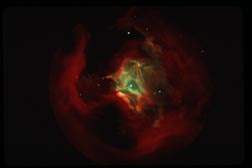
|
|
|
ARE WE ALONE?--Mysterious Nebula in New Hayden Planetarium Show: THE SEARCH
FOR LIFE. |
|
Some cynics suggested that this uncertainty—or apprehension—indicated that we, as earthlings, were afraid that beings and societies were developing rather more effectively beyond our orbit.
Recent events at the dawn of the 21st Century, however, now raise an even more provocative question: "Is There Intelligent Life on Eart?"
As for Outer Space—or even within our own Solar System—expectations seem to have been somewhat scaled back. At the Rose Space Center, the goal is now more simply phrased: "The Search for Life." If we can at least find live bacteria on Mars, what a relief!
This will show that WE ARE NOT ALONE!
The new Hayden Planetarium show explores some of these possibilities.
And it demonstrates that some previous ideas about Life on Earth—or almost Inside It—have been proven incorrect. On the great projection-dome of the Planetarium, images of strange marine life in the deepest depths of earth's oceans provide vivid evidence that living forms can survive even in intense heat.
Frankly, the inaugural Space Show—narrated by Tom Hanks—was more interesting than this one, which is narrated by Harrison Ford. It made mind-boggling use of the new Zeiss projector to suggest the incredibly vast expanses of the ever-expanding Universe.
For Millennia, Earth was believed the Center of the Universe. Galileo was almost burned at the stake for insisting it was not. Giordano Bruno, alas, went up in smoke for the same Lapse in Faith.
In the Hayden's initial star-sky-space show, its viewers' range of vision moved far out from earth, its solar system, its galaxy, on beyond galaxies of billions of solar systems, into unfathomable space. A space that is constantly expanding…
This is tough stuff for most folks to think about. In All of Space, where exactly is Heaven located? Does the Taliban get to go there? What about Hindus and Animists?
If Earth and its Peoples are under the Special Providence of God, what about all the Rest of Creation?
Or are we really not all that important in the Grand Epic Universal Scheme of Things?
So maybe it was a good idea for the Hayden to downscale its "main-tent show" to something a bit less frightening. And a bit more optimistic.
Unless, of course, those Martian bacteria could prove an even more deadly menace than Men from Mars?
Natural History Goes To the Ballgame!
B A S E B A L L AS A M E R I C A
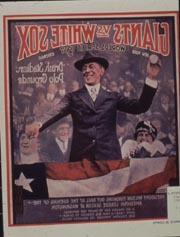
|
|
|
WOODROW WILSON THROWS OUT WORLD SERIES FIRST-DAY BALL--Baseball Poster
at Natural History Museum. |
|
And yet, if the AMNH can mount magnificent exhibitions of the rituals, games, past-times, costumes, totems, arts, crafts, and beliefs of tribal groups in remote corners of the world, why not also examine one of America's most obsessive rituals, games, and past-times? Not to overlook its costumes, totems, arts, and crafts? Nor the beliefs of some Americans that Babe Ruth was the Best Ever!
Drawn from the collections of—and curated by—the Baseball Hall of Fame in Cooperstown, NY, this astonishing show features more than 500 treasured artifacts. Among them are the "Doubleday Ball," Jackie Robinson's jersey, and the bats of Roger Maris, Babe Ruth, and Mark McGwire.
A totem of this show—which will later tour nine American cities—is the cornerstone from the long lost Ebbets Field in Brooklyn. Advance scouts have advised that opening festivities should include Hank Aaron, Stan Musial, Bob Feller, Warren Spahn, Earl Weaver, Lou Brock, and many other Baseball Greats.
At the Guggenheim Museum—
Rachel Whiteread's TRANSIENT SPACES
[Closing June 5, 2002] At the top of Frank Lloyd Wright's Guggenheim Museum—in the long narrow white gallery that intersects with the Great Modernist Rotunda—squats an immense white plaster construction.It is made up of panels cast from the inside of Rachel Whiteread's new home/studio.
You cannot enter into it. The great white form almost crowds out to the walls, so you cannot really back off from it to admire its cubic volume. Or its Architectural, Historical, or Social Significance.
Beyond it, at the opposite end from the narrow, almost claustrophobic, entrance-tunnel to the gallery, is a smaller Whiteread sculpture. This is also white plaster, a right-angled construction, cast from her basement stairs!
The building itself—from which these bland casts were made—was apparently destroyed in World War II and subsequently reconstructed. It was transformed by various occupants for varied uses.
So it can be said to Have A History. This is good, for the two sculptures are believed to "articulate the artist's preoccupation with architecture as a reflection of personal memory and history and as a means to addressing larger social forces."
Thomas Krens, the resourceful director of the Guggenheim, calls Whiteread: "one of the most formidable sculptors of our time. Her unique approach to the discipline is clear in these pieces, which possess an intense physical presence and communicate a deep sense of humanity."
As both blocks of plaster are very large—and they are on site—they do have Physical Presence. If they were intended to communicate a deep sense of humanity—which they certainly do not—Whiteread might well have given them less ambiguous titles.
The big white block is called Untitled (Apartment) (2001) . The right-angled stairwell is Untitled (Basement) (2001) .
MoMA has a Whiteread "sculpture" on the roof of Sette MoMA. It looks very much like a clear acrylic copy of the wooden water-drums that top most Manhattan buildings.
For such breath-taking inspirations—or Original Artistic Conceptions—she has earned a reputation as a creator who has "transformed ordinary domestic objects and architectural spaces into poetic sculptures that explore the relationship between memory, architecture, and the body—and the private and the public realms."
Wow! Not even George W. Bush—or God Himself—gets reviews like that!
Once again, it is necessary to note that the true artistic creativity evident today in major museum and gallery exhibitions is largely confined to the wall-texts of super-inventive curators.
After all the lavish curatorial & critical verbiage squandered on Conceptualist-Minimalists such as Whiteread, one wonders what is needed to win attention with a new sculpture of something from the world of reality—Living or Dead—which actually does communicate "a deep sense of humanity"?
Michelangelo and Rodin, eat your hearts out! Wherever you may now be—as artists-in-residence—or otherwise employed…
Is there Sculpture in Heaven? Or only in the Other Place? We have recently learnt that there is certainly NO SCULPTURE in the Taliban Paradise.
Fortunately—for New Yorkers and tourists alike—the towering Brazilian Baroque Golden Altar from Olinda is still in place in the Wright Rotunda. This alone is worth a trip to the Guggenheim!
Whiteread should try her plaster-cast technique on this convoluted sculptural masterpiece.
GUGGENHEIM EXPANSIONIST NOTE:
The Whiteread objects d'plaster were commissioned by Deutsche Bank for the Guggenheim Museum Berlin, located centrally on the Unter den Linden. [Which makes me glad my Berlin bank-account is with the Dresdner Bank: they surely aren't squandering depositors' monies on projects such as this?]The Frank Ghery Titanium Canopy added to the Frank Lloyd Wright Fifth Avenue Guggenheim for the recent Ghery Show is not weathering well. This architectural fragment is both a reminder of the Ghery Guggenheim in Bilbao, Spain. And a possible foretaste of the immense Ghery Guggenheim promised for the Lower East Side and the South Street Seaport Area.
Unfortunately for other expansionist Guggenheim museum projects in Manhattan, the Guggenheim Soho did not work out.
So it is now the fabulous new PRADA showcase, designed by Rem Koolhaas. More people are flocking to this reconstruction/renovation than ever visited the often challenging Guggenheim art exhibitions below Houston.
Art Shows at the 7th Regiment Armory—
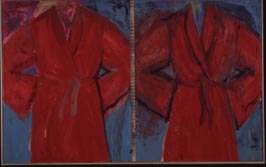
|
|
|
RED SWEETIES--Ladies-wear by Jim Dine at AADA Armory Show. |
|
ADAA's Art Show 2002/
Sanford Smith's Works on Paper/
Diane & Meg Wendy's March Antiques Show
The tank-tracked heavy-duty US Army combat-vehicles have at last left the
streets beside the Park Avenue Armory.
The camouflage-clad National Guard soldiers have retreated to the upper floors of the 7th Regiment Armory. [The food in the Mess—which is open to the public—is even worse than combat rations.]
The Main Floor—vast enough for full military drills—is once again home to a variety of art and antique shows of varying appeal and quality. It is good to have them back!
The most high-profile of these shows customarily open as benefits for such worthy institutions as the Brooklyn Museum of Art and the Henry Street Settlement. The latter was the beneficiary of the 14th annual Art Show of the Art Dealers Association of America, or ADAA.
I knew I was seeing some outstanding works—old and very new—at the ADAA show. But it remained for The Observer's demanding critic, Hilton Kramer, to canonize this year's edition as "A Complete Triumph."
Were Our Designated Leaders suddenly to declare America in a State of Permanent Emergency—and set about organizing life, art, and work for the Common Good—the new Culture Czar could confiscate most of the artworks on view at the ADAA show and have an admirable core-collection for the New National Museum.
Among artworks which caught my eye were the unusual images of Kurt Trampedach at the Allan Stone Gallery stall. Feininger and other German Expressionists at the Achim Moeller booth were, as usual, arresting.
Brad Marshall's American Landscapes at the Fischbach gave a new gloss to images of nature iconized by Bierstadt and Church.
Henry Darger's demented comic-strip fantasies are also haunting, but in a quite different way. Galerie St. Etienne showed At Cairns Fair They Are Carried Off, which makes Balthus' obsession with pre-pubescent girls seem almost straight-forward.
Seventy art-dealers showed their wares at the Armory. Works ranged from Rembrandt and Goya, through Munch and Picasso, to Avery, Motherwell, Pollock, and Hockney. Gerhard Richter's work—also to be seen in the current MoMA retro—was on offer.
Sanford Smith's always intriguing Works on Paper provided a benefit for the Citizens' Committee for Children of New York, or CCC. [During the Great Depression, these letters stood for Civilian Conservation Corps, which soon filled the ranks of the US Army when the Japanese bombed Pearl Harbor!]
Each of these Works on Paper shows over the past three years has improved in quality and has astonished with some outstanding new artworks. As well as having dazzled with the profusion of original works by major American artists—many of whom have passed over into the Pantheon of Modern Classics.
Of course, some of the handsome images on offer are not original works of art. After all, limited editions of engravings and prints—though not the original artwork—are also on paper and eminently collectible.
The same is true of photographs, but it is preferable if they are also from limited editions, instead of being endlessly reproduced from negatives.
As for colorful posters, there is never a shortage, especially of French poster-art from the Belle Époque up to World War II. There must be warehouses full of Toulouse-Lautrec's most famous images…
Rare books—especially with remarkable plates—are also works on paper, and Ursus Books had some admirable volumes on display.
Among the dealers with works I'd have been eager to buy—had I money enough and some vacant wall-space—were Jean Pettibone, David & Constance Yates, Carolyn Staley, Mary Ryan, and my long-time favorite, The Old Print Shop!
Diane & Meg Wendy are tireless organizers of Art & Antiques shows. And not only at the Armory, or even in Manhattan! The Wendys—without a Peter Pan—fly over to New Jersey and up to Connecticut for interesting shows.
It would seem that there is no Quality Control in some of these Wendy shows, for some of the booths feature wares that one might find on a barrow or in a stall on Portobello Road in London.
But other dealers are offering silver, ceramics, furniture, fabrics, sculptures, and paintings of very fine quality. Some major pieces of furniture seem like Old Friends, as they are often on view. Or is it simply that handsome vintage dining-tables with 12 matching chairs all look alike after while?
It is amazing to consider the effort required to truck in large pieces of furniture from galleries and shops far outside New York City, in hopes that they might find buyers in Manhattan that they could not command in Providence or Portland.
Were I to become a dealer, I think I'd want to specialize in small objects and items. Less fuss to carry about from show to show!
Obviously, although glass paperweights with millefleurs cores are fairly small, you wouldn't make as much on a sale as you could with an even smaller item, such as a diamond brooch. Still, there's less risk of theft with paperweights! [Loney]
Copyright © Glenn Loney 2000. No re-publication or broadcast use without proper credit of authorship. Suggested credit line: "Glenn Loney, Curator's Choice." Reproduction rights please contact: jslaff@nymuseums.com.